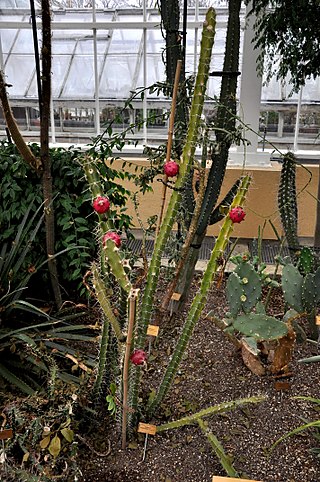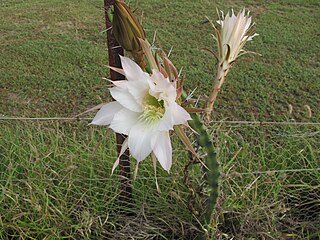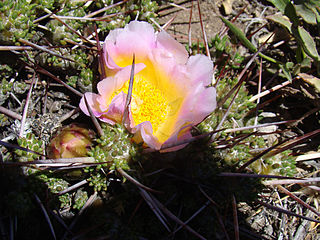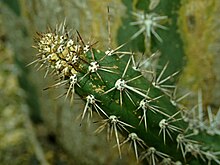
Harrisia is a genus of night blooming cacti.

Quiabentia zehntneri is a species of plant in the family Cactaceae. It is endemic to Brazil. Its natural habitats are subtropical or tropical dry forests and subtropical or tropical dry shrubland. It is threatened by habitat loss. Common names are “Quiabento”, “Flor de Cera” and “Espinho de São Antonio”.

Harrisia aboriginum, the west-coast prickly apple or prickly applecactus, is a species of columnar cactus endemic to peninsular Florida, on the Gulf Coast of the counties of Lee, Sarasota County, and Charlotte. Only 12 occurrences are known, and the species is threatened by horticultural collection, shading from fire suppression, competition from invasive flora, and most of all habitat destruction. It is a federally listed endangered species of the United States.

Harrisia bonplandii is a species of cactus. The cactus plants in the Gran Chaco are generally called tuna and this specific variety reina de la noche. Fruits and roots are edible and well known to the native nations of the Gran Chaco.
Harrisia gracilis is a species of cactus found in Jamaica.

Harrisia fragrans is a rare species of cactus known by the common name fragrant prickly apple. It is endemic to Florida, where it is known only from St. Lucie County. The plant's habitat has been almost completely consumed by development, leading to its rarity. It is a federally listed endangered species of the United States.

Harrisia martinii, commonly called the Martin applecactus, is a species of night-blooming, rope-like cacti native to South America. With large showy flowers that attract the hawk moth, it is considered by some a useful landscape plant in areas that do not freeze.

Harrisia pomanensis is a species of cactus.

Harrisia portoricensis is a species of cactus in the genus Harrisia. Its common names include higo chumbo and Puerto Rico applecactus.

Ferocactus peninsulae is a barrel cactus in the genus Ferocactus of the family Cactaceae.

Ferocactus robustus is a barrel cactus in the genus Ferocactus of the family Cacteae.

Armatocereus cartwrightianus is a species of Armatocereus from Ecuador and Peru.

Lobivia pampana is a species of Lobivia found in Peru.

Maihuenia patagonica, commonly known locally as chupasangre or siempre verde, is a succulent cactus shrub native to Chile and Argentina. Maihueniapatagonica is remarkably tolerant to moisture and cold temperatures.

Matucana haynii is a species of Matucana found in Peru.

Harrisia brookii is a species of cactus found in the Bahamas.
Harrisia adscendens is a species of cactus found in Brazil.

Harrisia eriophora is a species of cactus found in Cuba.
Harrisia fernowii is a species of cactus found in Cuba.

Borzicactus sepium is a species of Borzicactus found in Ecuador.


















